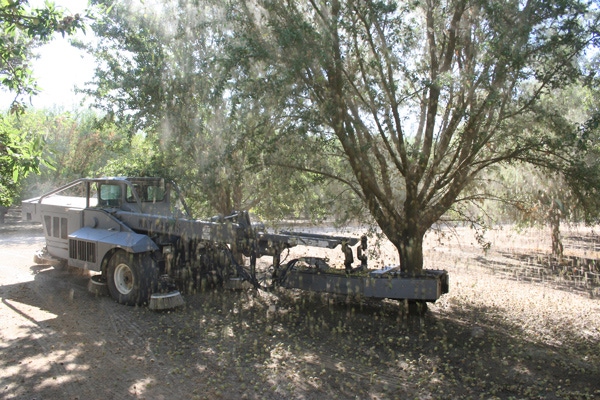March 10, 2016

Foreign pressures have pushed tree nut prices down, and the crunch is being felt most severely by walnut growers, followed by growers of almonds and pistachios.
But some say the good news is that the dip in prices has a self-correcting quality. As prices drop, demand increases and that bodes well for producers who remain bullish.
“Prices are still good,” said Chuck Nichols, who grows almonds and pistachios in the Hanford, Calif. area. “I did cotton for 30 years and know what low margins are.”
“I remain bullish on nuts,” said Jim Zion, a managing partner with Meridian Growers in Clovis, Calif.
Zion says, “It’s a fantastic food. It’s healthy, and there are still people around the world who don’t know what a pistachio is. Nuts are a portable protein, easier to ship than a pork chop or hamburger, and there’s burgeoning demand on the sport side.”
To bolster demand domestically, the walnut industry has unleashed a barrage of videos on how to use its product – in salads, entrees, and desserts. Strange as it seems, some realized that people simply did not know what to do with a walnut when it came to food preparation.
Commenting on the effort to build increased demand in the United States, Dennis Balint, chief executive officer of the California Walnut Commission, said it’s too early to tell how successful it may be.
“We can stimulate interest,” he said, “But when the consumer is in the store, they have to find our product. Our strength has been baking. But walnuts are versatile. If you go into the store, you find us in baking. I hope that changes.”
Zion says walnuts generally fall into the ingredient category, pistachios are seen mostly as a snack, and almonds are “the best of both worlds.”
At a walnut day presentation in Visalia, representatives of the California Walnut Board and Commission outlined their efforts to build domestic demand as world demand declines and acreage for walnuts grows - as for all California tree nuts.
Jennifer Olmstead, domestic marketing director, pointed out that world production of walnuts has increased in recent years. This has spawned a domestic campaign to tout the “heart healthy” use of the nut in a variety of dishes, with television ads showing just how simple it is to use them.
“People don’t know how to use them,” Balint said.
In recent months, the commission has peppered national cable television with spots in TV markets including Boston, Chicago, Chico-Redding, Denver, Fresno, Los Angeles, Milwaukee, New York, Philadelphia, Sacramento-Modesto-Stockton and Seattle-Tacoma.
Balint said having to stimulate demand is something that has not been critical for many years.
“It’s like turning a large ship,” he said. “It takes time and momentum. It’s not like parking your Honda.”
Olmstead and Balint believe the downturns in prices will “open doors” domestically and abroad which will stimulate use and grow demand over time.
“It’s a good product,” Balint said. “It’s hard to keep a good product down. It’s been used for thousands of years, and this is just a bump in the road.”
Not all of those in the walnut industry are sanguine. Mike Poindexter, chief executive officer of Poindexter Nut Co. in Selma, said he does not think walnut prices will recover to levels seen two years ago.
“Our inventory is up and we are in oversupply,” he said. “I don’t want to sound too pessimistic, but it’s not rosy. I think about 25,000 acres that are not producing top quality walnuts – some of older Ashley, Tehama, Eureka and Serr varieties - need to be pulled.”
Those in the nut industries point to a combination of factors that have driven prices down, including competition from abroad and the weakening in the economy of some of California’s biggest export markets, including China.
The strong U.S. dollar also contributed.
In India, Zion said some importers did not honor contracts for almonds, and in fact abandoned containers.
“They did not want to take a loss,” he said.
On the pistachio side, Zion says Iran was selling nuts at a lower price abroad.
Pistachio producers in California are looking to rebound from a bad year in 2015 during which many trees produced blanks and the 275 million pounds produced was lowest since 2003. Low chill hours were blamed, and the hope is that this year there has been a boost in chilling.
Iran had bumper crops in 2014 and 2015, said Richard Matoian, executive director of American Pistachio Growers.
“In a worldwide market, we can’t just look at what we’re producing here,” Matoian said.
He said pistachio prices have only dropped slightly, about 5 percent.
Zion said prices for almond growers dropped about 20 percent. Prices to walnut growers dropped 60 percent and higher, Poindexter said.
Zion pointed to the use of pistachios and almonds over time in various forms – from almond milk to pistachio crusted salmon to trail mix and cereals.
“We can’t depend on just one segment,” he said.
Zion believes the declining prices should translate to lower prices for consumers.
“We’re not immune to the laws of supply and demand,” he said. “We go through cycles. This is my fourth almond cycle. We’ll build demand again and find ways to use them more.”
You May Also Like




